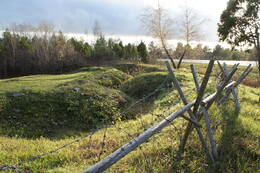Pirmojo pasaulinio karo apkasai prie Mažojo sąsiaurio
Karas salose prasidėjo 1917 metų rugsėjo 29 dieną, kai vokiečių kariuomenė išsilaipino Saremos saloje prie Tagalahe.
Pirmasis pasaulinis karas šių salų krantus pasiekė 1917 m. rugsėjo 29 d., kai Saremos Tagalahte išsilaipino vokiečių kariuomenė.
Nors Saremos ir Muhu salos buvo Petro Didžiojo karinės jūrų tvirtovės dalis, statybos darbai pradėti 1915 m. pabaigoje, o įtvirtinimai ir apkasai buvo nebaigti arba buvo prastos būklės dėl skubotų statybų. Vietos gyventojai nemažą sumą uždirbo padėdami statybose. Netgi žmonės iš Linnuse kaimo talkino kasant apkasus.
Įtvirtinimai prie Orissaare buvo pranašesni, tačiau vokiečių jūrų pėstininkai šias pozicijas užėmė pirmąją operacijos „Albion“ dieną ir panaudojo jas prieš Rusijos pajėgas.
Įtvirtinimus aplink Väinameri sąsiaurį prižiūrėjo kontradmirolas Dmitrijus Svešnikovas. Jo štabo viršininkas buvo Nikolajus Rekas, kurio globėjai buvo kilę iš Saremos. Vėliau Reekas Estijos Respublikoje pakilo iki generolo laipsnio.
Muhu dislokuotų pajėgų vyriausiasis vadas buvo Aleksejus Martynovas, kurio 118-oji pėstininkų divizija, kurią sudarė 15 000–20 000 vyrų, buvo išsiųsta kaip pastiprinimas ginti salą prieš pabėgant iš panikos prieš pat atvykstant vokiečiams.
Apkasuose prie sąsiaurio abiejose Väinatamm kelio pusėse buvo vadinamas Talino mirties batalionas: tik 800 vyrų, atvykusių spalio 1 d., vadovaujami kapitono Pavelo Shishko. Mūšiai dėl plento vyko dieną prieš tai. Muhu tako galas buvo nusėtas besitraukiančių Rusijos pajėgų palikta artilerija ir amunicija. Iš pradžių bėgančius rusų kareivius buvo galima pamatyti kertant taką, bet sutemus tai baigėsi, nes vokiečiai užėmė kitą tako galą. Kitą rytą dvi mažos valtys priartėjo prie Rusijos gynybinių pozicijų ir atidengė ugnį. Mirties batalionas reagavo tuo pačiu būdu, atidarydamas ugnį, po kurio valtys atsitraukė. Tai pasikartojo spalio 3 ir 4 d. ryte. Rusai panaudojo šalia kelio paliktą senesnio tipo artilerijos pabūklą, pastatydami jį miške. Virš apkasų ore įvyko vokiečių ir rusų naikintuvų muštynės. Vokiečių lėktuvas ir du jo pilotai nukrito Linnuse kaime. Spalio 3 d. Mirties batalionas apleido apkasus pietinėje kelio pusėje ir susirinko prie Vahtnos, tikėdamasis vokiečių išsilaipinimo, nes nebuvo įmanoma pulti per kelias. Spalio 4 d. vakare vokiečiai pradėjo nuožmią Muhu pakrantės bombardavimą. Mirties batalionas gavo įsakymą trauktis iš Mažojo sąsiaurio. Väinatamm kelias buvo padengtas minomis. Vėliau paaiškėjo, kad detonavo tik viena mina, nepadarė daug žalos.
1-asis ir 2-asis estų batalionai atvyko į Muhu salą spalio 3 d., o Kuivastu mieste juos sutiko chaosas ir netvarka. Štabo kapitonas Peeteris Kannas, dirbantis bataliono gretose, gimė ir užaugo Muhu mieste. Batalionas neturėjo jokių galimybių dalyvauti jokiose kautynėse, nes visiškai trūko organizuotumo.
Spalio 5 d., per susirėmimą Raugiuose, dauguma vyrų pateko į vokiečių nelaisvę. Vokiečiai suskubo paklausti pirmųjų pagautų vyrų apie vėjo malūnus. Dėl vėjuoto oro visuose malūnuose buvo malami grūdai, o Koguvos moterys ryškiai raudonais sijonais buvo užkopusios į Andrusės-Tõnisės vėjo malūno viršūnę apžiūrėti didžiulių karo laivų. Vokiečiai buvo tikri, kad tai kažkoks kodas, todėl susprogdino vėjo malūną. Laimei, moterys tuo metu jau buvo išvykusios. Iš viso iš Mirties bataliono pavyko pabėgti 114 vyrų ir penkiems pareigūnams. Apie 200 vyrų iš Estijos bataliono saugiai perėjo Didžiojo sąsiaurį ir grįžo į savo dalinį. Tarp jų buvo Peeteris Kannas. Iš viso Muhu į nelaisvę pateko 5000 vyrų ir 600 karininkų (tarp jų 1598 kariai iš Estijos bataliono).
Datos nurodytos pagal senąjį kalendorių.
Tada jis buvo vadinamas Zinovjevo tiltu Livonijos gubernatoriaus garbei.
Mirties batalioną sudarė ištikimi ir ryžtingi kovotojai, kurie prisiekė kovoti tol, kol jų kūne nebeliks kvapo.
Medžiaga iš Muhu muziejaus archyvo kolekcijos.
Oskar Kurvits, Estijos nacionalinės armijos dalinių kūrimas 1917-1918, 1-asis Estijos pulkas. Talinas, Bendruomeninis gyvenimas 1930 m
Susijusios vietos
Pirmojo pasaulinio karo apsauginiai grioviai prie Veikės sąsiaurio
Aiškiai matoma Pirmojo pasaulinio karo apkasų atkarpa prie Mažės sąsiaurio yra šalia Kuivastu–Kuressaares kelio, netoli populiaraus turistų lankomo objekto – Eemu vėjo malūno Muhu saloje.
Šie apkasai sudaro nedidelę dalį didesnio gynybinių įtvirtinimų ir įrenginių, besidriekiančių daugelį kilometrų, teritorijos. Jie buvo kasami 1915–1917 m. kaip gynybinė priemonė nuo artėjančios vokiečių armijos ir buvo naudojami abiejų pasaulinių karų metu.
Atnaujinta vieta yra puikus Muhu karinės istorijos pavyzdys. Šis vingiuotas apkasas yra aiškiai matomas. Lankytojai jį lengvai pasiekia, nes jis yra prie pat pagrindinio kelio, o šalia jo yra automobilių stovėjimo aikštelė. Istorinė vielinė tvora tik papildo kraštovaizdį.
Šis karinės istorijos pavyzdys papildo netoliese esantį istorinį Eemu vėjo malūną – pramoninio paveldo objektą, kuris išgyveno Pirmąjį pasaulinį karą, bet buvo sunaikintas Antrajame pasauliniame kare, o vėliau restauruotas 1980 m.





